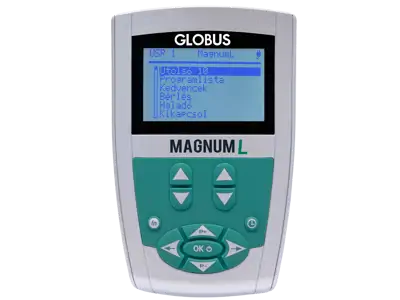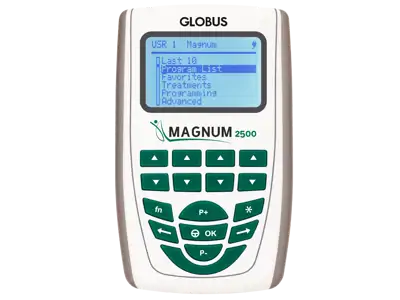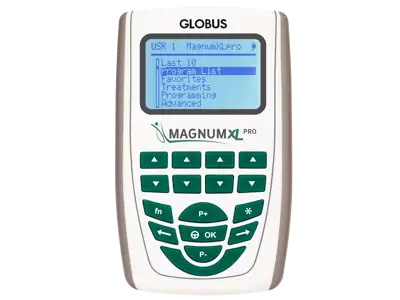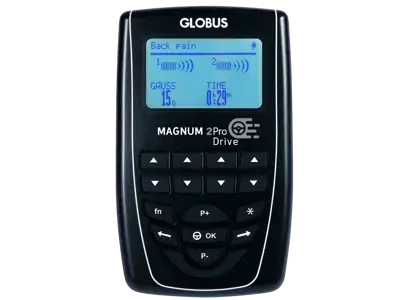Magnetotherapy device
Magnetic therapy is a medical physiotherapy device used worldwide to treat musculoskeletal disorders.
Medical devices that use coils to create a pulsating magnetic field are used in medicine. For treatments, a medium magnetic intensity (100 Gauss to 10000 Gauss) is used. Home devices typically provide an intensity of 100-500 Gauss.
Magnetic therapy: Biological effects
- pain relieving (increases the production of endogenous opiates - painkillers - in the body)
- reduces inflammation in and around joints
- increases cell membrane permeability and thus aids cell metabolism, stimulates the elimination of oedema and fluid retention
- enhances microcirculation and lymphatic circulation
- biostimulates cellular processes
- provides cellular support and stimulates the cellular metabolism, protein synthesis, thus accelerating the healing process
- normalizes cell membrane potential (the electrical potential of a damaged cell membrane is disrupted, causing cellular functions to stop)
- increases cellular energy production
- increases bone-building cell activity, bone formation, calcium incorporation into bone
- stimulates immune function
- enhances the body's resistance
- accelerates the body's ability to fight disease and regenerate by supporting the body's self-healing processes
- reduces muscle stiffness
- improves nerve cell conductivity
- supports nerve cell regeneration
- stimulates epithelial and connective tissue production, wound healing
Applications of magnetotherapy
- Stimulate osteoporosis
- Stimulate bone crack and fracture healing (also through plaster
- stabilization of loosened prosthesis
- stimulation of implantation after implantation
- relief of joint pain
- treatment of arthritis
- treatment of osteoarthritis
- arthritis of the elbow, golf elbow, bursitis, tendonitis, Achilles tendon pain
- leg ulcers, bedsores, burns
- soreness and circulatory disturbance caused by diabetes
- trigeminal neuralgia
- spastic (stiff) muscle relaxation, post-stroke
- treatment of sleep disorders
- Parkinson's disease, Alzheimer's disease, multiple sclerosis
- treatment of sports injuries, reduction of haematoma
- surgical wound healing
- immune system strengthening, etc.
How to choose between the Magnum magnetotherapy device models?
The main differences between the devices are the number of treatment channels, the intensity of the magnetic field and the number of treatment programmes.
Number of treatment channels
The Magnum L can only be connected to a single magnetic actuator, so buy one if you want to stimulate the healing of a fracture in a wrist or elbow.
The Magnum XL, 2500, XL Pro and 3000 Pro have two channels at a time. With the 3000 Pro, it is possible to run different programs on the two channels (for example, a bone fracture program on one output and an arthritis program on the other). This is important if, for example, you are treating two patients at the same time or your partner has a musculoskeletal problem. With the Magnum XL, 2500, XL Pro you can operate two operators at the same time, but only with the same programme. That means, for example, if you have inflammation in both knees, you can treat them at the same time.
The Magnum 3500 Pro is a four-channel device, so you can treat up to four channels at the same time. In 2+2 mode, you can set different programs on outputs 1-2 and 3-4, meaning you can run two patients and up to 2 full-body mats at the same time.
Magnetic Intensity
I mentioned above that intensities lower than 100 Gauss are used for biostimulation, regeneration treatments, while those between 100-1000 Gauss are used for healing treatments. Consequently, higher intensity results in a stronger healing effect. The higher the magnetic field intensity of a device, the higher its price. You have to find the right compromise between the complaint and your budget.
Just because the magnetic intensity is low does not mean that the device is not effective! With a lower intensity device, more treatment will be needed for improvement and healing. It's like driving a car: if you drive slower, it takes more time to reach the finish line. But you'll get there.
Number of treatment programs
The more expensive the device, the more pre-designed treatment programs it contains. Treatment programs are created based on medical experience and guidelines. A different frequency, intensity and treatment time is needed for a minor (e.g. wrist tendon) inflammation, such as an Achilles tendon or even a fracture of the femoral neck or osteoarthritis.
If a device has few programs, they are for "general" treatment, such as a fracture of a bone in general. In more expensive devices, this is then precisely broken down into several programs, i.e. there is a specialised program for wrist, humerus, tibia or femur fractures, etc.
You don't necessarily need the device with the most programs! But the one that suits your current needs. That could be the Magnum L. Magnum XL and XL pro also offer rehabilitation and beauty-wellness programmes. The Magnum 2500, 3000 Pro and 3500 Pro can be suitable not only for home treatments, but also for physiotherapy clinic treatments.
A quick guide to comparing Magnum devices
| Magnum device version | L | XL | 2500 | XL Pro | 3000 Pro | 3500 Pro |
| No. of channels | 1 | 2 | 2 | 2 | 2 | 4 |
| Multiple patient treatment | not | not | not | not | yes 1+1 ch. | Yes, 2+2 ch. |
| Intensity per channel (Gauss) | 120 | 140 | 160 | 200 | 200 | 200 |
| max. Intensity (Gauss) | 120 | 280 | 320 | 400 | 400 | 800 |
| rehabilitation programs | 8 | 16 | 52 | 32 | 70 | 70 |
| beauty programs | none | 10 | none | 12 | none | none |
| for home use | yes | yes | yes | yes | yes | yes |
| for medical use | no | no | yes | yes | yes | yes |
| for a cosmetician | no | yes | yes | yes | yes | yes |
| mattress connection | no | yes | yes | yes | yes | 2 |
| bone fractures | yes | yes | yes | yes | yes | yes |
| osteoporosis | yes | yes | yes | yes | yes | yes |
| artrosis | yes | yes | yes | yes | yes | yes |
| artritis | yes | yes | yes | yes | yes | yes |
| tennis elbow | yes | yes | yes | yes | yes | yes |
| oedema | yes | yes | yes | yes | yes | yes |
| tissue regeneration | not | yes | yes | yes | yes | yes |
| scars, wounds | yes | yes | yes | yes | yes | yes |
| sleep disorder | no | no | yes | no | yes | yes |






